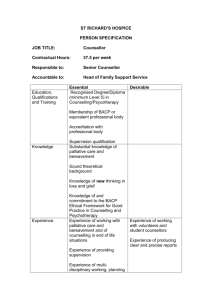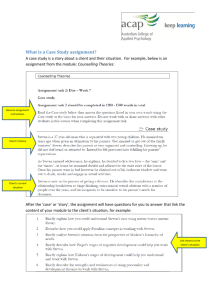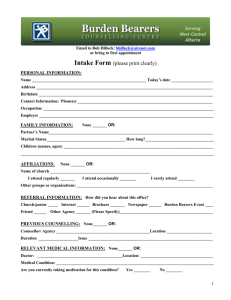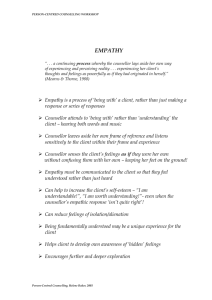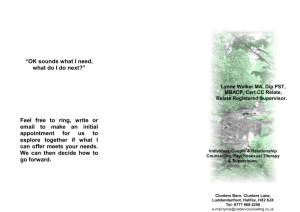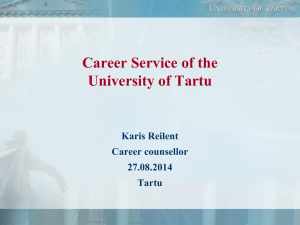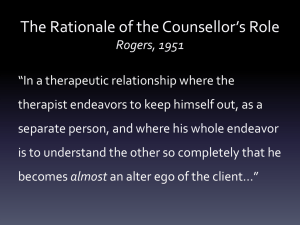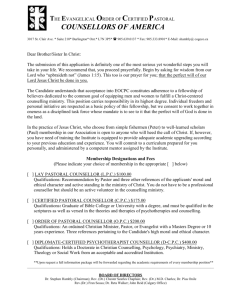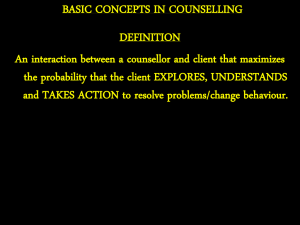WSD Assessment Presentation - Supporting Refugee Children
advertisement
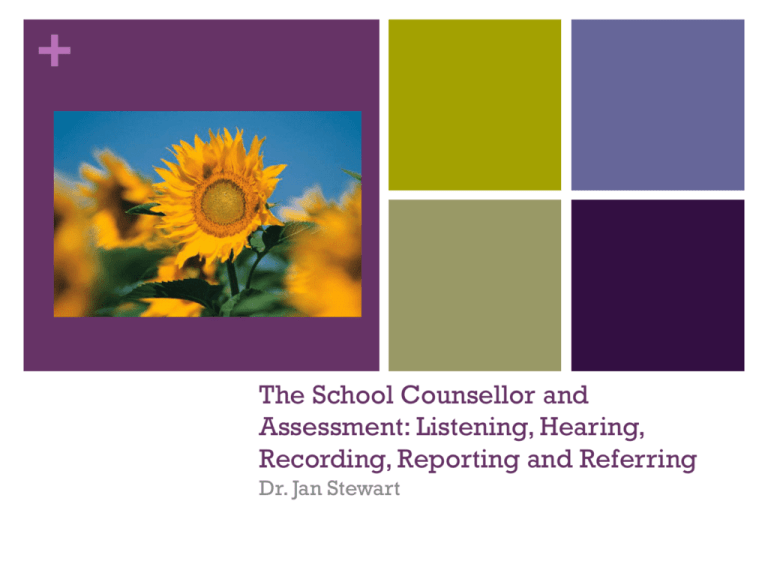
+ The School Counsellor and Assessment: Listening, Hearing, Recording, Reporting and Referring Dr. Jan Stewart + OF AS IN FOR Assessment of counselling (programs, services and counsellor’s skills) Assessment as counselling (data, paraphrasing, probing, listening, hearing) Assessment in counselling (recording, referring, data, action research, ) Assessment for counselling (evaluating, promoting, justifying) + School Counsellor Evaluation Little attention has been placed on the evaluation of specialists and counsellors. There are some school systems that have developed criteria for evaluating the practice of school counselling. (program planning and organization, group and individual counselling skills and processes, consulting skills and processes, guidance presentation, coordination of services, ethical practice and professional development) + Assessment: What does this mean for the school counsellor? What do you want to know? Who should be involved in designing the evaluation? Who are the outside experts to conduct the evaluation? What instruments and processes will be developed as part of this evaluation? Who will receive the results of the study and how will they be used? (Schmidt, 2008, p. 268) + What will Be Evaluated? What are you supposed to be accomplishing? What are your major roles and functions? Discuss 1. Counselling individuals and groups 2. Consulting with students, parents, and teachers, individually and in groups 3. Appraising students’ interests, abilities, behaviours, and overall educational progress 4. Coordinating student services in the school. + Three Overarching Approaches 1. Assess the outcomes of particular practices and activities selected by the counsellor to address specific concerns 2. Assess counsellor success, as with program evaluation. 3. Measure counsellor performance by combining first two outcomes (The next step is to gather data using specific methods) + Gathering Data Observations Audio and Videotaping Interviews Self-Assessments Portfolios Products Customer Feedback Schedules and Records Personnel Memos + Portfolio Products Program Planning Counselling Consulting Coordinating Student Appraisal Professional (split Performance and Development into 6 groups and list all of the evidence you could put in each of these categories + Portfolio + Student Survey 1. The counsellor was available to see me when I needed assistance this year. 2. The counsellor listened to my concerns and seemed to understand me. 3. The counselling sessions helped me focus on my concerns and make a decision. 4. The counsellor kept information I shared in counselling confidential. 5. I would recommend the counsellor to other students who need services. 6. MTS 3Rs/Assessment stuff/Student survey.docx + Self-Assessment MTS 3Rs/Assessment stuff/School Counsellor Self.docx Structured Interview of Counselling + Relationship (Interview with a counsellor) Ideally, used in a series of interviews about same case. 1. Understanding the client’s concerns and appropriate use of diagnostic methods and procedures. Q: Tell me about the concerns of the student you are seeing, How does this student perceive the main issues, problems, and areas of concern? Q: Describe the assessment procedures you have used and how the results of these methods led you to choose the intervention(s) you selected for this student? 2. Understanding of the helping process and the stages of a counselling relationship. Q: Where are you and the student in your relationship at this point? Relate the progress you have made to the phases of a helping relationship. Q: Given the nature of the student’s concerns, are you satisfied with where the helping relationship is at this point? + Structured Interview Continued 3. Knowledge of the counselling approaches and techniques Q: tell me about specific techniques , strategies , and interventions that you have used in this counselling relationship. Q: what was the rationale for choosing these approaches? 4. Use of evaluation methods to assess progress. Q: how much longer do you expect to be seeing this student? Q: What are your goals for the remainder of the counselling relationship? Q: What methods do you plan to use to evaluate the overall success of this intervention? + Structured Interview Continued 3. Knowledge of the counselling approaches and techniques Q: tell me about specific techniques , strategies , and interventions that you have used in this counselling relationship. Q: what was the rationale for choosing these approaches? 4. Use of evaluation methods to assess progress. Q: how much longer do you expect to be seeing this student? Q: What are your goals for the remainder of the counselling relationship? Q: What methods do you plan to use to evaluate the overall success of this intervention? + MTS 3Rs/Assessment stuff/CHECKLIST 1.pdf MTS 3Rs/Assessment stuff/Checklist 2.pdf MTS 3Rs/Assessment stuff/Checklist 3.webarchive + Listening, Hearing, Recording, Reporting, and Referring: Assessing Basic Counselling Skills + Relationships, Records, Referrals Listening Communicating Hearing Responding Recording Role-playing Referring Reporting Ethical Dilemmas Promoting your Program + Listening Hearing: physiological Attending: process messages dimension of listening of filtering and focusing Understanding: making sense of the message Responding: giving observable feedback to Remembering: the ability to recall information speaker (Adler and Towne, 1996) + + ACTIVITY 1 Work together in a group of 4. Pick a subject of importance to all of you. Spend five minutes discussing the topic, but instead of trying to understand one another’s positions, each member should try to dominate the conversation and convince the others to accept his or her position. Debrief (How did you feel during the discussion?) Discuss how frequent this sort of poor listening occurs in your everyday life. Pick another topic of interest. This time, use a small object (keys, ball) as the prop that allows the person to talk. The person with the object is the only one who can speak. When he/she is finished, pass the object to another person. Discuss how the two conversations differed. Consider the “one speaker at a time” rule and how it can change the quality of your everyday conversations. + Why Don’t We Listen??? Message Overload Preoccupation Rapid Thought Effort External Noise Hearing Problems Faulty Assumptions Lack of Apparent Advantages Lack of Training + Types of Nonlistening Pseudolistening: imitating the real thing. Give the appearance of attention. Counterfeit communication. Stage-Hogging: Conversational Narcissists. Turning topic on themselves. Interrupters. Selective Listening: Respond only to the parts that interest them. + Types of Nonlistening Insulated Listening: Avoiding a topic Defensive Listening: Innocent remarks are treated a personal attacks Ambushing: Listen carefully and then use it to attack Insensitive Listening: Can not look beyond words to understand hidden meaning conveyed in nonverbal clues. + Analyze this… + Active Listening Conversations as part of a counselling process should be comprised of therapeutic or helping dialogue. Interpersonal communication encompasses four main components (Egan, 2009) 1. Turn Taking 2. Connecting 3. Mutual Influencing 4. Co-creating Outcomes + Focusing on Counselling 1. Before the session, make sure your physical needs are taken care of (thirst, hunger, bathroom, stretching) 2. Look at the speaker. Taking a few notes can keep you on task; mentally put masking tape across your mouth. 3. Watch your body language! 4. Encourage the speaker to continue with short, gentle comments like “uh-huh”, “really!?”, “tell me more”, etc. If the person is not normally talkative, you may have to refer to your brief one or two word notes and ask an open question. + ACTIVITY 2 Turn taking and connecting Work with a partner. Practice the art of turn taking and connecting. (Three turn takers and three connections) Get three objects from each of the two piles and put them in the centre (between the talker and the listener) Use the discussion starters on the next slide. + What do you do on Sundays? What kind of food do you like? Who has had the most influence in your life? What do you think you will be doing five years from now? When do you feel best? In the morning, afternoon, or evening? If you could live anywhere in the world for a year, where would it be? If you knew could you try anything and not fail, what dream would you attempt? What super-power would you most like to have, and why? Are you a beach, country or city person? How do you spend your free time? Tell me about a favorite event of your adulthood or childhood Non-Verbal Communication + Bodily Behaviour General Appearance Eye Behaviour Facial Expression Space Physical Characteristics Voice Related Behaviour Observable Autonomic Responses + + TUNING IN….SOLER S: Face the client squarely O: Adopt and Open posture L: Lean toward the client E: Maintain eye contact R: Be Relaxed (EGAN, 2009) + + Soler and Not so Soler Activity 3 Work with two other people (group of 3) 1/3 out in hall (These are the counsellors) Choose a topic (serious) to discuss with a counsellor (people in room) One person is the counsellor, one is the client(student) and one is the observer Discuss the topic/event and have the counsellor do as is discussed. + Questions about Tuning In What are my attitudes towards this client? How would I rate the quality of my presence to this client? To what degree does my nonverbal behaviour indicate a willingness to work with the client? What attitudes am I expressing in my nonverbal behaviour? What attitudes am I expressing in my verbal behaviour? To what degree does the client experience me as effectively present and working with him/her? To what degree does my nonverbal behaviour reinforce my internal attitudes? In what ways am I distracted from giving my full attention to this client? What am I doing to handle these distractions? How might I be more effectively present to this person? + What About Bob… + Questions about Tuning In-Post Bob... What are the counsellor’s attitudes toward this client? How would you rate the quality of the counsellor’s presence to this client? To what degree does his nonverbal behaviour indicate a willingness to work with the client? What attitudes are expressed in the counsellor’s/client’s nonverbal behaviour? What attitudes are expressed in the counsellor’s/client’s verbal behaviour? To what degree do you think the client experiences the counsellor as effectively present and working with him/her? To what degree do you think the counsellor’s nonverbal behaviours reinforce his internal attitudes? How might the counsellor be more effectively present to this person? + Nonverbal Activity 4: Wordless Acting Determine one student in each group as student A, and one as student B. Give each student a copy of the script below. Student A will read his lines out loud, but student B will communicate his emotion (reading lines) in a nonverbal way. Provide B with a secret emotional distraction that is written on a piece of paper. For example, student B may be in a rush, may be really bored, or may be feeling guilty. After the dialogue, ask each student A to guess what emotion was affecting the student's partner student B. + Nonverbal Activity 5: Move Now 1. Cut several strips of paper. 2. On each strip of paper, write down a mood or a disposition like guilty, happy, suspicious, paranoid, insulted, or insecure. 3. Fold the strips of paper and put them into a bowl. They will be prompts. 4. Have each student take a prompt from the bowl and read the same sentence to the class, expressing the mood they’ve picked. 5. Students will read the sentence: "We all need to gather our possessions and move to another building as soon as possible!" 6. Students should write down assumptions they make about each student as they read their prompts. + + Assessing the Client + Is what you heard, what the student has said? Hearing + Processing What you Hear Identify What Key messages and feelings are the main points here? What experiences and actions are most important? What themes are coming through? What is the client’s point of view? What is most important to him/her? What does he/she want me to understand? What decisions are implied in what she/he is saying? What is he/she proposing to do? (Egan, p. 113) + Understanding Clients through Context People are more than the sum of their verbal and non-verbal messages. It is important to understand the clients’ stories, points of view, and messages and the emotions that permeate them through the wider context of their lives. Culture, personality, personal style, ethnicity, key life experiences, education, travel, economic status and other forms of diversity all provide the context and part of the client’s story. + Good Will Hunting Scene 1 + Context, Stage, Approach, Style Context: The background, circumstances of the client’s life. How do these circumstances affect the way the client deals with his/her problems and opportunities Stage: Developmental stage or the age-related psychosocial tasks and challenges the client is currently facing Approach: The client’s approach to coming to know and make sense of the world. How does the client construct meaning. What is right and important? Style: Personality. How does the client’s personality style and temperament affect understanding of self and his/her approach to world. + Blind spots and blank spots What slant is the client putting on stories? What issues need to be challenged. Skilled helpers listen to the client’s stories, points of view, decisions, intentions and proposals, but also to any slant or spin that the clients might give their stories. Clients often leave out key elements when talking about problems and opportunities. Having frameworks for listening can help you spot the important things that are missing. + Good Will Hunting Scene 2 + Informational Listening and Responding to Student Talk Less (two ears-one mouth) Get rid of distractions (phones, television, or internal preoccupation with your own problems) Don’t judge prematurely (Listen, Understand, Evaluate) Look for Key Ideas (most people have a central idea) Ask Questions (make sure you receive the speaker’s thoughts and feelings accurately) Paraphrase (reword the interpretation of a message their thoughts or feelings behind their words) + Paraphrasing IS your understanding of the client’s inner world correct. Reflecting is a way to help others by understanding them better 1. Is the problem complex enough? 2. Do you have the necessary time and concern? 3. Are you genuinely interested in help the other person? 4. Can you withhold judgment? 5. Is paraphrasing in proportion to other responses? + + Activity 6-Paraphrasing Practice Are you saying…? Do you mean? It sounds like…? If I understand you correctly, you are saying … So you are saying… Right? Did I get that right? Work with a partner and choose an event or experience that made your frustrated, angry or sad. Talk to your “counsellor” about the issue. The counsellor should use examples of paraphrasing throughout. Remember that as the counsellor…you should play it back using a tentative tone. + Activity 6-Paraphrasing Practice Follow Up Speaker : Did you feel you were being sympathetically heard? What percentage correct was the speaker? Ten percent? 90%? How come? Listener : How was it to listen with the understanding you would be paraphrasing back to the speaker? Did you feel you were “on the same page”? If not, why not? Don’t worry if you are not completely accurate. That is why the listener “plays it back” to the speaker using a tentative tone. Remember! The person may forget what you said, but will never forget how you made them feel! + Empathy Empathy is a value, a way of being that should permeate all communication skills Tune in carefully (physically and psychologically) to hear the client’s point of view Set judgments and biases aside Listen for core messages Pay attention to verbal and non-verbal Respond with highlights frequently but briefly to understand client’s core message Be flexible and tentative Keep client focused + Empathy Move gradually toward the exploration of sensitive topics and feelings After sharing a highlight, attend to cues that confirm or deny accuracy of your response Determine whether your highlights are helping client focus and stimulate clarification of key issues Note signs of client stress or resistance Keep in mind that the communication skill of empathy is just one tool to help clients see themselves and their problem situations more clearly Take special care when the client’s personal culture differs considerably from your own + Empathy- Pillow Talk A problem has 4 sides and a middle P1: I’m right you’re wrong P3: Both right, both wrong P5: There’s truth in perspectives P2: You’re right, I’m wrong P4: The issue isn’t important + Good Will Hunting Scene 3 + Recording + Recording is the practice of writing down pieces of information, often in a shorthand and messy manner. The listener needs to be discreet and not disturb the flow of thought, speech or body language of the It can keep you on track, but it can also be distracting for the client. At the same time, if you don’t take notes, how will you be able to remember what happened last session? If you are away, how will the alternate counselor know what is going on? When the person is actually conveying her/his situation and concerns, you may want to take minimal notes – writing down a few words for each major area – as a memory jog. The real note taking comes later. + + IDAPE Issue Data Assessment Plan Evaluation/recommendation + Activity 7-IDAPE Use the sheet (WSD) to record communication in counselling session. Watch the movie clip and determine what information to include. + + + + Activity 8 IDAPE Continued In treatment (22) + IDAPE Post “In Treatment” I: suppressed feelings, guilt, rejected by father, he perceives that he is rejected by his own family, difficult with relationships, not wanting to be looked after, self-deprecating, unresolved loss issues (after brother died), he did not have a childhood, experience in Vietnam, 68 and looking back and feels like he has wasted his life, he has no one to look after anymore, built value system on doing instead of being, value system on material things- emotional piece did not matter, product of that time period (boys don’t cry). D: lost job, lost brother, contamination of medication, maybe forced early retirement, guilt about brother’s death, took over business, war vet. A: unfinished business, loss, guilt, relationship building, transference, develop a new way of being. P: two choices, wrap back up with meds or continue finding self. E: refer for more intense counselling, family therapy, self-help work, wellness, don’t devalue work he has done for others, need a balance. + Referring School counsellors recognize their boundaries of competence and provide only those services and use only those techniques for which they are qualified by training or experience (MECY, 2007, p. B13). School counsellors shall make appropriate referrals when their professional assistance cannot meet students’ needs (MECY, 2007, p. B13) + Referral Sources School counsellors shall be knowledgeable about referral resources (MECY, 2007, p. B13). Whenever possible and appropriate, school counsellors shall make referrals with the knowledge and consent of students. At all times, counsellors shall act in the best interests of the students (MECY, 2007, p. B13). + Referral CCPA B18. Referral When counsellors determine their inability to be of professional assistance to clients, they avoid initiating a counselling relationship, or immediately terminate it. In either event, members suggest appropriate alternatives, including making a referral to resources about which they are knowledgeable. Should clients decline the suggested referral, counsellors are not obligated to continue the relationship. (CCPA, Code of Ethics) + Two kinds of Referrals Referrals to counsellor Counsellor-initiated referrals + A foundation… Ivey and Ivey’s five-stage helping model is suggested as a foundation for approaching counselor-initiated referrals systematically. The stages are: initiating, gathering data, mutually setting goals, working on a constructive action plan, and terminating. + Initiating and Gathering Data The basic counseling competencies are paramount because most if not all eventual referrals begin with counseling or consulting relationships. Mutually Setting Goals Basic challenging or influencing skills are also a part of the referral function. Working on a Constructive Action Plan and Terminating Basic questions are where to refer clients and how to refer them. When responding to these questions, counselors are challenged to acquire information about referral sources and develop systems for keeping that information and offering reciprocal referral assistance. How counselors introduce referral suggestions may be the most important facet in the referral process. Partial referrals are an option that may be the best choice in some instances, and counselors may be able to help the process succeed by participating actively (e.g., arranging appointments) + Referrals to the School Counsellor These referrals may be a source of satisfaction and frustration. Frustration occurs when the referral function is misunderstood, expectations are unrealistic, and referrals are made inappropriately. These frustrations dictate a need to organize the system by which referrals are made to counselors. Three basic questions are suggested as a foundation for organizing a system. Who is my client? What is the proper referral procedure? What is a legitimate referral? + Referring and Coordinating Receive referrals from other professionals Have the right skills to make referrals Know what to do with referrals he/she receives Manage referrals Coordinate the process once referrals have been made or accepted Collaborate with important service providers beyond school setting + Reporting Child Abuse Protocol Suicide Threats Potential for Harm (self or others) Follow division policy on protocol to follow + + + + Activity 9- Ethical Issues Rotational Discussion Posts. + Scenario 1 1. The principal calls you in on a Monday morning and tells you that a group of three girls had been “touched” while swimming at a public pool on the weekend. The police were called and the perpetrator was arrested. The parents had called to inform your principal of the situation and had asked for you to speak with the girls. You call them together and you discuss the situation with them. + Scenario 2 A grade eleven student comes in to change her timetable. While you are speaking with her, she tells you that she is pregnant and that she is unsure what to do. She doesn’t have support at home and does not want her parents to know about it at all. + Scenario 3 The mother of an enrolling elementary school student tells you that if the child's father requests information regarding their daughter, you must not give him any information because she has custody of the child. She provides documentation which states that she is the custodial parent. + Scenario 4 A 14 year old male student tells you that he got into an altercation with his father the previous evening while trying to protect his mother and his father broke his arm. You have a very strong relationship with the student and you have been talking to him about the abuse that his mother suffers at the hands of his father. The boy tells you that he does not want anyone to know or he will have to leave the house and his mother would be in danger. + Scenario 5 You have been working with a fifteen year old student for the past year. She has discussed some delicate family issues with you and you have been helping her to maintain a strong relationship with her family. Her parents come to see you and want to know what she has been discussing with you. + Scenario 6 Gloria has recently taken a positionas a school counsellor in a large middle school. She has been asked by the administration to plan to see a student who has frequently been referred to the office for inappropriate school behaviour to explore underlying circumstances and possible triggers. Gloria explains to the administrator that even though she would not be judgmental, she would be violating her boudaries as a school counsellor by becoming involved with discipline issues. She feels her relationship with students in general would be damaged and that they would not come to her with legitimate counselling issues. + Scenario 7 You are an elementary school counsellor. You have recently made a report to CFS regarding your suspicions about neglect and possible abuse. CFS looked into it but have not opened the case. She lives with her father who has custody. The father is very angry with the school about the report. Her teacher notices cuts on the girl’s arms. When you discuss this with the student, she denies it but you suspect self-harm. How do you proceed? + How to enhance the referral process providing information about your services providing examples of how the services are manifested delineating a referral system explaining the system proactively + Activity 10-Making Movies Work with a partner (counsellor and counselee) Write a counselling script where you exhibit the skills you have learned about (Active Listening, SOLER, Paraphrasing, Empathic Listening, Responding, Recording) Use Ivey’s Five Stage Model Write the script on paper, decide what you will each say and then do a digital recording of the interaction. Show to class Checklist of Positive Behaviours + Group Checklist of Counselling Skills Pre-Activity 10 Decide as a class what key skills we will be looking for in the counselling role-plays Use three samples and create our own Use Checklist 1, 2 and 3 as samples. Can we create our own acronym that will work for us? ACTIVITY 11- Informed Consent What are the key components of this kind of letter? + Promoting Your Program + ACTIVITY 12- Promoting Your Program Design a pamphlet for advertising your counselling program Include information on what services you offer Who you work with How to make an appointment A note on ethics and confidentiality Others… + Special Thanks to our actors and actresses and assistants… Jonathan Duhaime Ashley Roach Laura Davey From The University of Winnipeg Theatre Department And to our IT assistant Jerald Wake from the Faculty of Education, University of Winnipeg + Guidance Forms Record Keeping and Program Evaluation + Needs Assessments A systematic process of data collection and analysis Identify what goods/services are needed Purpose is to help define and solve problems To find out what can make a program more effective + + + Data Collection Results Elementary Elementary-Total Number of Contacts November January February March Elementary-New Referrals Elementary-Number of On-Going Cases November January February March Men tal H ealth New Reg is tra tions Lega l Frien ds hi ps Hom e Is s ues Fina nc ia l Figh ting A ca dem ic A ng er M anag eme nt A tte ndan ce Beh av io ur Bully ing/T eas i Care ng er/P os t S ec on dary Con f lic t Res oluti on Dea th/Lo ss Div o rc e/ Sep arat ion 130 120 110 100 90 80 70 60 50 40 30 20 10 0 Preg nanc y al/Em otion al A bus e Phy s ic al Hea lth /A s s ault Soc ial Skills Sex ualit y Hara ss A bu se teem Time table Suic ide Stre ss Stud y Sk ills /T es t P rep Sub s tan ce A bus e Sex ual Sex ual Self -Es Rela tions hips /Dat ing Sc h olars hips Phy s ic 50 45 40 35 30 25 20 15 10 5 0 + Data Collection Results Junior High + Junior High-Total Number of Contacts November January February March Junior High-New Referrals Junior High-Number of On-Going Cases November January February March Men tal H ealth New Reg is tra tions Lega l Frien ds hi ps Hom e Is s ues Fina nc ia l Figh ting A ca dem ic A ng er M anag eme nt A tte ndan ce Beh av io ur Bully ing/T eas i Care ng er/P os t S ec on dary Con f lic t Res oluti on Dea th/Lo ss Div o rc e/ Sep arat ion 200 180 160 140 120 100 80 60 40 20 0 Skills Time table Suic ide Stre ss Stud y Sk ills /T es t P rep Sub s tan ce U s e/A bus e Soc ial Sex ualit y al/Em otion al A bus e Phy s ic al Hea lth Preg nanc y Rela tions hips /Dat ing Sc h olars hips Self -Es t eem Sex ual A bus e Sex ual H aras s /A s s aul t Phy s ic 100 90 80 70 60 50 40 30 20 10 0 + Data Collection Results High School High School-Total Number of Contacts November January February March High School-New Referrals High School-Number of On-Going Cases ues Ment al He alth Lega l Home Is s Frien ds hip s Finan c ial Fight ing orde rs e/Se para tion Eatin g Dis Div or c Deat h/Los s Care er/Po s t Se c ond ary Conf lic t R es olu tion Bully ing/T eas in g Beha v iour A tten danc e A nge r Man agem ent A c ad emic 275 250 225 200 175 150 125 100 75 50 25 0 /Datin g Time table Suic i de Stres s Stud y Ski lls /Te s t Pr ep Subs tanc e A bus e Soc ia l Skill s Sex u ality Sc ho lars h ips Self Es tee m Sex u al A b us e Sex u al Ha ras s /A s s ault Relat ions h ips Preg nanc y New Regis tratio ns Phy s ic al/E motio nal A bus e Phy s ic al H ealth 275 1216 250 225 200 175 150 125 100 75 50 25 0 + Promoting Your Program
